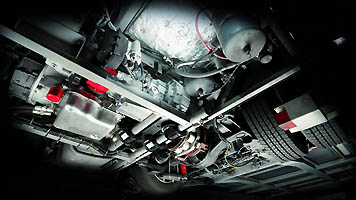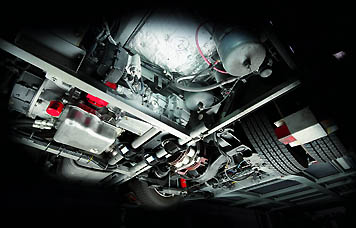
Completed prototype system ready to roll

The UK-based Flybus consortium reached a significant milestone in September with its successful integration of prototype hardware into an Optare Solo Midibus. The Flybus system uses a Ricardo Kinergy flywheel as the energy storage medium and a Torotrak continuously variable transmission (CVT) as the means of transferring energy between the wheels and the flywheel. The entire installation, which the company says should cost significantly less than current electric hybrids, mounts on the existing transmission’s power take off facility.
Like electric hybrids, flywheel hybrids recycle the kinetic energy that would otherwise be wasted during braking. As the bus decelerates, the CVT transfers energy from the vehicle wheels to the flywheel, spinning it up to speeds of 60,000 rpm. As the vehicle pulls away the CVT returns energy from the flywheel to the wheels, reducing the engine power requirement and lowering fuel consumption.
“The recovery and reuse of kinetic energy during stop-start drive cycles is a priority for bus operators, not just because of the positive impact on emissions but also because it reduces fuel costs and brake wear,” says John Fuller, product leader for Kinetic Energy Recovery Systems (KERS) at Torotrak. “Initial estimates suggest that the Flybus system could be available at a fraction of the cost of an electric hybrid, with fuel savings comfortably in excess of 10 percent.”
The Torotrak CVT, the key enabler of this technology, can transfer in excess of 60kW of power in a package weighing less than 10Kg. High levels of efficiency, together with torque control, make the technology an ideal fit for a flywheel drive.
The Ricardo’s Kinergy flywheel uses a compact and low cost magnetic coupling to transmit torque to the flywheel while providing the required step-up gearing. A magnetic drive facilitates flywheel operation within a sealed vacuum, while eliminating the need for inefficient mechanical gearing and rotating seals. The result is a system that exhibits very low levels of power loss.
Fuller says the continued advances in flywheel hybrids make them an increasingly attractive alternative to conventional hybrid systems.
